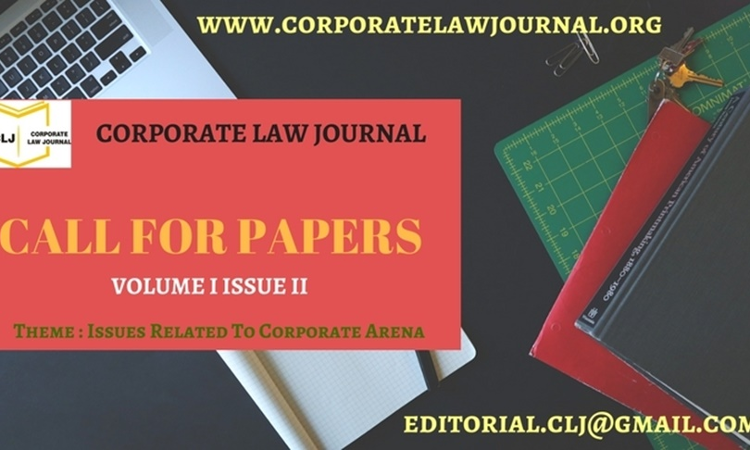Call For Papers: The CRIL Journal Of International Law And Policy
LIVELAW NEWS NETWORK
15 Dec 2023 12:49 PM IST

In its previous iteration, the Journal featured articles covering a diverse array of themes ranging from international criminal and humanitarian law to trade law and state responsibility. It has now been rebranded as the CRIL Journal of International Law and Policy.
The theme of the journal includes any contemporary and pertinent development in the field of international law and policy. The scope of this journal includes, but is not limited to, fields such as Public International Law, Human Rights Law, Private International Law, International Trade Law, International Commercial Laws, International Criminal Law, and International Investment Laws. The authors are encouraged to write on, or take an inter-disciplinary approach to, any field(s) or law(s) related to international law and policy.
SUBMISSION CATEGORIES
1. Long Article: 5000-8000 words
2. Short Article: 3000-5000 words
3. Case Study / Case Note 1500-3000 words
4. Book Review: 1000-2000 words
Kindly note, the word-limit is exclusive of the footnotes and exclusive of the abstract.
CITATION STANDARDS
1. The footnotes must adhere to the standards of the Oxford University Standard for Citation of Legal Authorities (4th ed., 2012) (OSCOLA 4th edition).
2. The authors are discouraged from using speaking or substantive footnotes. 3. Use of endnotes or hyperlinks would not be accepted.
GENERAL SUBMISSION GUIDELINES
Co-authorship up to a maximum of two authors is permitted.
The submitted document must include an abstract of 250-300 words in the beginning, highlighting the structure and the essence of the manuscript. The abstract is exclusive of the word limit of the manuscript.
Submissions must be made only through the Google Form available on our website, and Call for Papers published on various platforms.
The manuscript must be submitted on or before 23:59 hours on 30 September 2021.
Submissions must be a word document (in .doc or .docx format). They must be compatible with Microsoft Word 2007 or above.
The document uploaded should not contain any information that can be used to identify the author(s).
Submissions which do not confirm to these guidelines may be rejected at the sole discretion of the Editorial Board of the Journal. CRIL reserves the right either reject, or send the manuscript back to the author(s) for any modification(s) at any stage, in the event of non-conformity with any of the submission guidelines.
LAYOUT AND STYLISTIC GUIDELINES:
Title [Times New Roman, 16 points, 1.5 line spacing, Bold, All Caps, Centre Aligned]
Heading Level 1 [Times New Roman, 14 points, 1.5 line spacing, Bold, Small Caps, Centre Aligned]
Heading Level 2 [Times New Roman, 12 points, 1.5 line spacing, Italics, Each word capitalized, Centre Aligned]
Heading Level 3 [Times New Roman, 12 points, 1.5 line spacing, Italics, Each word capitalized, Left Aligned]
Main Body [Times New Roman, 12 points, 1.5 line spacing, Justified, 1-inch margin on all sides] Footnotes [Times New Roman, 10 points, 1.0 line spacing, Justified]
Abstract [Times New Roman, 12 points, 1.0 line spacing, Italics, Justified Aligned]
Spellings should follow the British system of spelling. Word-endings -ise and -isation are preferred over -ize and -ization.
EVALUATION STAGES AND PARAMETERS
A. Preliminary Review
- All manuscripts submitted must be original and unpublished. Plagiarism of content as well as that of an idea would lead to a direct rejection of the manuscript. The Editorial Board of the Journal reserves the right to reject a submission if any instance of plagiarism is detected.
- Submissions are required to have proper citation of authorities. Any manuscript received without footnotes shall be outrightly rejected without a review.
- Paraphrasing without appropriate citation of authorities shall also qualify as plagiarism.
- Secondary plagiarism, or plagiarism of the authorities cited may also be a ground for rejection of the manuscript.
B. Content Review
Manuscripts accepted in the Plagiarism Review shall be subjected to a Content Review. In the first stage of Content Review the manuscripts are evaluated on the following parameters:
1. Grammar and Language
The language of the submission must be easy to understand. It should use concise sentencing. Author(s) are encouraged to maintain a uniform voice throughout the article. Rhetoric is discouraged.
2. Structural and Logical Coherency
The arguments advanced by the Author(s) must be logically sound. The Author(s) should introduce, contextualize, and conclude the arguments effectively. A clear structure of the manuscript should be maintained.
3. Contemporary Relevance
The subject-matter of the manuscript should be one that relates to recent developments, or lacunae in the topic addressed. The Author(s) are encouraged to contextualise their ideas, and emphasise on the importance of the topic addressed in the manuscript.
4. Contribution to Existing Literature
The manuscript must be one that positively contributes to the discipline. Over-referencing, or reiterating arguments already made on the particular topic should be avoided.
5. Research and Referencing
The authorities relied on must be authoritative, and be appropriate for the purpose they are being cited for. Marks may be deducted for both over-referencing, or under-referencing. The citation standard prescribed by the Journal (OSCOLA 4th edition) must be strictly adhered to.
Manuscripts accepted in the first stage of review shall be sent for peer review. Scrutiny at this stage too is done on the above-mentioned parameters.
For the brochure, click here


